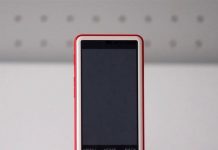 An interesting comment from Amazon Kindle Review on this today:
An interesting comment from Amazon Kindle Review on this today:
Thanks to this comment from Benjamin that better explains why Sharp are trying for their own format –
The most important thing for this Sharp reader is that it’s going to have Japanese language books on it. That’s a market that isn’t really served by anyone else (even Sony) at this point, and Sharp will probably be very successful with it.
I wouldn’t be entirely surprised if they’re simply forced to make their own document format. I’m not entirely sure about the technical details of ePub or Mobi or whatever, but I wouldn’t be surprised if they don’t work with CJK characters, which are obviously necessary for Japanese language books.
And while Japanese is frequently written in horizontal left-to-right lines nowadays, books are still written in vertical lines, starting from the right side of the screen and moving to the left. This would probably take a lot of hacking to get working with current ebook file formats, and is most likely the biggest obstacle to a Japanese Kindle.
It’s certainly a big enough market for an e-reader. There are about 130 million people in Japan and they have both disposable income and a well-known love for gadgets. I bet a lot of people would be willing to buy an e-reader to read on the train to and from work.
Basically,
* Their use of a new format might be to support Japanese.
* Japan is not served by any dedicated eReader at the moment (not even a LCD one).
* There’s a large enough market (130 million people) to release a device.Plus Sharp can build on their success in Japan (if they do succeed) to expand outside of Japan. If Sharp with its Sharp eReaders ends up being the first company that makes eBook Readers popular in Japan then it will deserve a lot of credit.


































epub can show any Unicode characters just fine if the right fonts are available, but it does lack vertical text used in asian books. still… ugh, another format.
This sounds interesting, but the basic format that Sharp is expanding, is said to be the most popular format for e-mangas. mangas would just be like jpeg-ebooks: one image per page. All Sharp is adding to the format is audio and video.
Nothing is said about this aspect of displaying the characters.
So I rather doubt this has anything to do with it.
(the format has been around since 2002 IIRC.)
Actually, Japanese have been reading ebooks (and even more so, e-Manga) on trains for years – but on smart phones and mobile phones. Sony launched a Japanese ereader device in ’04 but later took it off the market as it never really caught on (the general consensus was it just wasn’t esthetically pleasing and too much trouble to load books via a PC vs quick download from a cell phone). In March ’09 Fujitsu launched the “FLEPia” in Japan, which was touted as the world’s first color eReader. Their press release at launch claimed the device came with access to a wide range of 20,000 Japanese titles, but also with a heavy price tag. It apparently hasn’t yet caught on widely.
In retrospect, I now understand why Amazon was not interested in the EPUB format at the beginning. If you want to create DRMed ebooks, there is absolutely no need to use any open format. We are VERY excited to know that the new HTML5 standards allow browsers to save ebook contents in a database on the local computer/device. The database is associated with its origin. Only the original website can access the database. Therefore, these ebooks are automatically protected. We shall call these browser-based ebooks “Web books” which can be read by any browser suppoting the HTML5 standards.
I found an EPUB file which allows you to test your ereader device or software’s support of Unicode characters: http://groups.google.com/group/epubcheck/browse_thread/thread/1f1c65a3555deaef?pli=1
Apparently it varies quite a lot, even within “official” EPUB software like Adobe Digital Editions.
DRMed books not requiring open formats is not correct. The protection mehod should simply be open as well. The ePub specification provides an example of how PKI can be used to encrypt books. The OPDS catalog-protocol could provide an attribute that allows an e-reader to obtain the private key that comes with a bookshop account. The bookshop could then always encrypt books for a customer using his public key. All this is very simple and completely open.
Japanese have been reading books in plain-text files for ages. The iPhone/iPod touch has a buckload of apps reading books from the Aozora Bunko project (their text versions; the project has HTML versions too). Some Japanese cell phones have built-in apps for that too.
I wouldn’t go as far as to say that those have a particular format, since they are merely plain-text files in Shift-JIS encoding, with a particular syntax for ruby.
Most apps intended to read those files display them vertically and from right to left, since that is how most fiction books in paper are printed.
I wouldn’t be surprised if Sharp went with something as limited as that (adding its own breed of DRM).